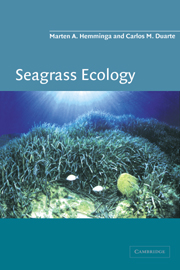1 - Taxonomy and distribution
Published online by Cambridge University Press: 29 September 2009
Summary
Introduction
Seagrasses comprise <0.02% of the angiosperm flora, representing a surprisingly small number of species (about 50, Table 1.1) compared with any other group of marine organisms. The limited species membership of the seagrass flora has directed some (still limited) efforts to the study of their origin and their evolution in an attempt to account for this phenomenon. A second path of research has tried to find clues for the paucity of species by studying the stress factors constraining angiosperm life in the sea. This second approach has driven much effort towards the analysis of seagrass distribution and the definition of the habitat requirements of seagrasses. The attention these issues have received extends beyond scholarly concerns, for seagrasses are, despite their limited diversity, important contributors to coastal marine ecosystems, both locally and at the global scale. In this chapter we shall provide an overview of the origin, evolution and present diversity of extant seagrasses, and describe their present distribution and the basic requirements that delimit their possible habitats. The definition of how seagrass distribution is regulated leads, in turn, to the assessment of their global extent and, from this, to the evaluation of the role seagrasses play on the global ocean ecosystem.
The seagrass flora
Seagrasses are generally assigned to two families, Potamogetonaceae and Hydrocharitaceae, encompassing 12 genera of angiosperms containing about 50 species (Table 1.1).
- Type
- Chapter
- Information
- Seagrass Ecology , pp. 1 - 26Publisher: Cambridge University PressPrint publication year: 2000
- 2
- Cited by

